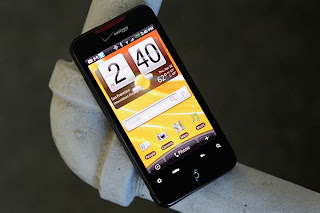 Measuring 4.23 inches long by 2.09 inches wide by 0.65 inch thick, the Reality almost matches the Rogue in terms of shape and size. It shares the Rogue's same boxy look, with curved corners and rounded edges, though it is a little lighter at 4 ounces as opposed to the Rogue's 4.94. The Reality also has a decidedly glossier sheen all the way around, which makes it much more susceptible to fingerprint smudges. It comes in both black and red, and has an interesting grid pattern on the back.
Measuring 4.23 inches long by 2.09 inches wide by 0.65 inch thick, the Reality almost matches the Rogue in terms of shape and size. It shares the Rogue's same boxy look, with curved corners and rounded edges, though it is a little lighter at 4 ounces as opposed to the Rogue's 4.94. The Reality also has a decidedly glossier sheen all the way around, which makes it much more susceptible to fingerprint smudges. It comes in both black and red, and has an interesting grid pattern on the back.The display is where we start to really see the difference between the Rogue and the Reality. Instead of the stunning 3.1-inch AMOLED of the Rogue, the Reality gets a relatively pedestrian 3-inch WQVGA display. This isn't to say it's bad-- we actually quite like the 262,000 color support and the 240x400-pixel resolution--but it just doesn't match up to the Rogue. You can adjust the backlight time, the shortcut icons on the main menu, the dial font size, the menu font style, the color of the lock screen font, the clock format on the home screen, and the transition effect between menus.
Like many other Samsung touch-screen phones, the Reality comes with the TouchWiz interface, which is a collapsible tray on the left side of the home screen that consists of several widgets and shortcuts. One of the widgets new to the Reality is a Communities widget that offers quick access to seven social networks and photo/video sharing sites, Facebook, Flickr, Twitter, Friendster, MySpace, PhotoBucket, and YouTube.

You can have up to three different home screens on the Reality, and the TouchWiz is accessible on all of them. You are also free to customize each home screen by dragging and dropping different shortcuts from the TouchWiz tray. Along the bottom row of each home screen are shortcuts to the phone dialer, the contacts list, the messaging menu, and the main menu. The phone dialer offers a roomy virtual keypad plus shortcuts to the contacts menu, groups, and favorites. You can also tap out a new text message via the virtual keypad and the T9 method if you don't want to use the physical keyboard for some reason.
The resistive touch screen is not as responsive as capacitive ones, but it's still intuitive and easy to use. You can add haptic and audio feedback to your finger taps if you'd like, and you can then adjust the vibration intensity, the sound effect, and the volume level.
Aside from the touch screen, you also get a few physical controls. There are the Send, Back/Clear, and End/Power keys underneath the display, and the volume rocker and screen lock key on the left spine. The charger jack is on the left side as well. On the right are the microSD card slot, the voice command key, the speakerphone key, and the camera/camcorder key. The speakerphone and voice command keys double as zoom controls for the camera. On the back is the camera lens and a self-portrait mirror. A 3.5-mm headset jack sits on top.
Slide the phone to the right, and you'll reveal a full four-row QWERTY keyboard. The keyboard is spacious and we like that each key is slightly raised above the surface for faster typing. There's a dedicated number row, a navigation array, and the typical shift and function keys. The A, W, S, D keys plus the navigation arrows are grayed out for gaming purposes. Unfortunately, the Reality's keyboard is much more cramped than the Rogue's and the keys themselves are smaller.
When you slide open the phone, the display changes orientation from portrait to landscape mode. The Reality also has an internal accelerometer that can change the screen's orientation without you having to open the phone, though this only works with certain applications, like the Web browser.
The Reality has a 1000-entry phone book with room in each entry for five numbers, two e-mail addresses, an instant-messaging screen name, two street addresses, a company title, a photo, a birthday, and a note. You can then assign contacts into groups and pair them with one of 17 ringtones and alerts.
Basic features include a vibrate mode, a speakerphone, a calendar, a calculator, an alarm clock, a stop watch, a world clock, a notepad, a sketchpad, and a timer. There's also voice command, USB mass storage mode, a file viewer that lets you read Microsoft Office documents, GPS with VZ Navigator support, and stereo Bluetooth.












